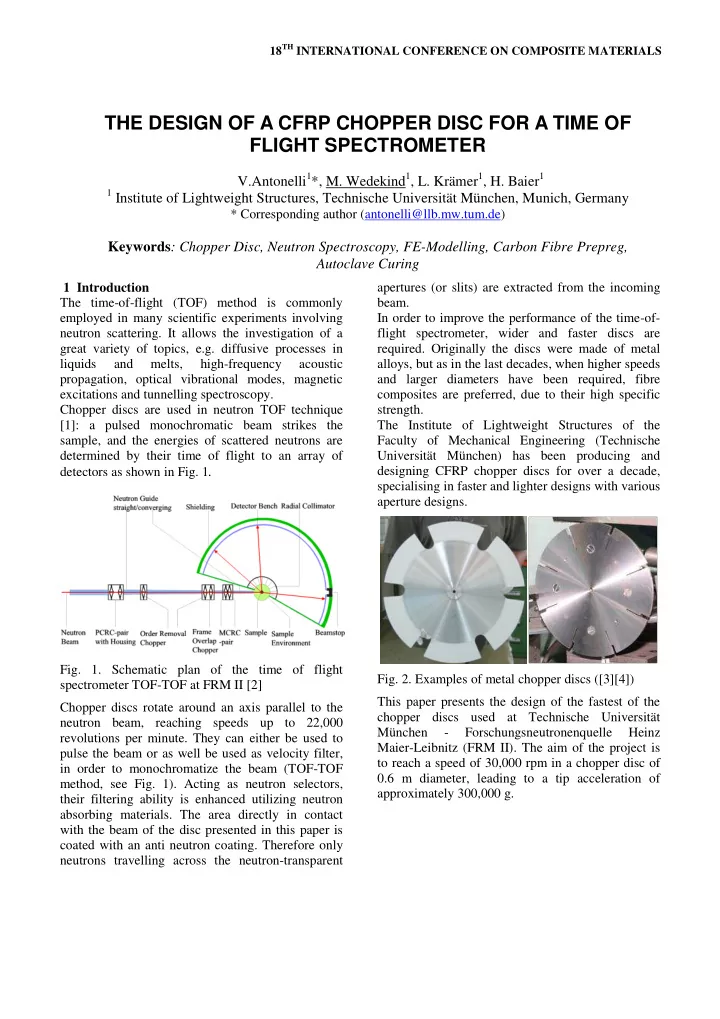

18 TH INTERNATIONAL CONFERENCE ON COMPOSITE MATERIALS THE DESIGN OF A CFRP CHOPPER DISC FOR A TIME OF FLIGHT SPECTROMETER V.Antonelli 1 *, M. Wedekind 1 , L. Krämer 1 , H. Baier 1 1 Institute of Lightweight Structures, Technische Universität München, Munich, Germany * Corresponding author (antonelli@llb.mw.tum.de) Keywords : Chopper Disc, Neutron Spectroscopy, FE-Modelling, Carbon Fibre Prepreg, Autoclave Curing 1 Introduction apertures (or slits) are extracted from the incoming The time-of-flight (TOF) method is commonly beam. employed in many scientific experiments involving In order to improve the performance of the time-of- neutron scattering. It allows the investigation of a flight spectrometer, wider and faster discs are great variety of topics, e.g. diffusive processes in required. Originally the discs were made of metal liquids and melts, high-frequency acoustic alloys, but as in the last decades, when higher speeds propagation, optical vibrational modes, magnetic and larger diameters have been required, fibre excitations and tunnelling spectroscopy. composites are preferred, due to their high specific Chopper discs are used in neutron TOF technique strength. [1]: a pulsed monochromatic beam strikes the The Institute of Lightweight Structures of the sample, and the energies of scattered neutrons are Faculty of Mechanical Engineering (Technische determined by their time of flight to an array of Universität München) has been producing and detectors as shown in Fig. 1 . designing CFRP chopper discs for over a decade, specialising in faster and lighter designs with various aperture designs. Fig. 1. Schematic plan of the time of flight Fig. 2. Examples of metal chopper discs ([3][4]) spectrometer TOF-TOF at FRM II [2] This paper presents the design of the fastest of the Chopper discs rotate around an axis parallel to the chopper discs used at Technische Universität neutron beam, reaching speeds up to 22,000 München - Forschungsneutronenquelle Heinz revolutions per minute. They can either be used to Maier-Leibnitz (FRM II). The aim of the project is pulse the beam or as well be used as velocity filter, to reach a speed of 30,000 rpm in a chopper disc of in order to monochromatize the beam (TOF-TOF 0.6 m diameter, leading to a tip acceleration of method, see Fig. 1). Acting as neutron selectors, approximately 300,000 g. their filtering ability is enhanced utilizing neutron absorbing materials. The area directly in contact with the beam of the disc presented in this paper is coated with an anti neutron coating. Therefore only neutrons travelling across the neutron-transparent
2 List of requirements This method is iterative and it allows designing a disc with equal stresses at every section interface. The important characteristics of a chopper disc are Choosing an initial value of it is possible to its diameter, its design speed and its maximum mass, calculate . Using these stresses it is possible to limited by the driving mechanism. A further determinate the four constants. important characteristic, given for each disc, is the Then it is necessary to calculate the stress gap amount and geometry of the apertures, providing the between the first disc and the second one. Imposing neutron-transparent apertures. Other boundary the following conditions: conditions concern the attachment of the disc to the driving mechanism, the collar. (1) In the introduction it is mentioned that the area, where the neutron beam passes through, needs to be neutron absorbent. In this way the neutrons can pass It is possible to find the stress gap: only through the opening apertures. Like aluminium, the performance of CFRP to absorb the neutrons is (2) not sufficient; therefore, in this area an anti neutron coating, e.g. based on boron ( 10 B), is applied. v 3 Chopper disc design Reflecting the convergence with infinitesimal small 3.1 Definition of cross-sectional geometry of a full ring elements the stress gap is getting zero. With this disc the optimal configuration of a rotating disc with constant strength is obtained. Due to design The cross section of the composite design is similar restriction shown later, this shape cannot directly be to the metal one, having a decreasing thickness with applied. Yet, the final design is based on the optimal increasing distance from the rotating axis. This is shape, regarding the functional requirements of the based on the Grammel’s criterion [5], used e.g. for system. sizing of flywheels. This criterion allows designing a high-speed rotating 3.2 Restrictions on cross-section of chopper disc disc of a varying thickness and constant stress. A As mentioned above, the Grammel’s criterion is high speed rotating disc is represented Fig. 3 using a valid in the case of an undisturbed disc, while in the series of annular discs of constant thickness. actual case the chopper is required to have a certain number of apertures. These openings can either be very narrow and long or very short and wide; depending on the specific use and spectrometer design. Fig. 3. Representation of Grammel’s criterion on an The number of apertures, their width and opening optimized rotating disc radius are given requirements, while the fillet (see Fig. 4) has to be designed according to strength According to [5] it is possible to calculate the consideration. optimal geometry of a rotating disc starting from an elementary disc with a constant thickness. The stress field of the first rotating disc is given by: fillet opening angle Where A, B, C and D are constant which are function of the geometry and of the angular velocity. Fig. 4. Geometry of the aperture
Recommend
More recommend